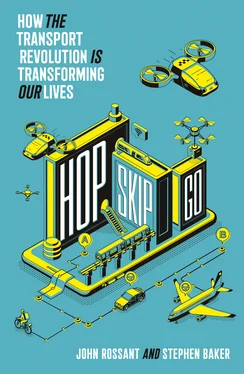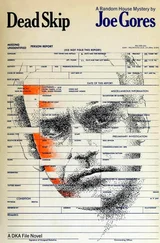Czinger arrived at this hub in 2014 with a bigger-than-life goal: to reinvent auto manufacturing for the next century. The reigning status quo, as Czinger sees it, features massive factories mass-producing cars and trucks. These plants are geared toward tonnage and are punishingly rigid. The vehicles rolling off their lines choke our cities and cook our planet. It’s a model, as Czinger sees it, well along the path to extinction. His alternative is designed to diverge from that death march, which is why Czinger named his company Divergent 3D. His model is fast and flexible, similar, in Darwinian terms, to the small, cagey mammals that survived cataclysmic climate change millions of years ago. Automakers large and small, in his view, need the same mammalian skills—speed and flexibility—to survive. That’s what Kevin Czinger wants to sell.
Czinger’s manufacturing setup, like so much else in the coming age of mobility, encodes the entire process in software. Like a magazine or a song, or a million other products in today’s world, the entire vehicle is pieced together virtually, on a computer. Once the engineers are happy with the design, they hit the Print button, and 3-D printers spit out panels and joints, each one optimized for weight, strength, durability, fuel efficiency—in short, whatever quality the engineers ask for. Later a small cohort of robots assembles the car, plunks in an engine (either gas or electric), and adds four wheels and a few finishing touches. If the car is not quite right, the Divergent team melts down the pieces, tweaks the design, and reprints. As Czinger sees it, this new process will allow entrepreneurs and small design studios to barrel into small-scale car manufacturing. Setting up mini–manufacturing plants, he says, will cost a tenth of the mass-manufacturing norm, perhaps only $50 million, and will give birth to all sorts of boutique automakers. “We could have ten new car manufacturers in LA alone,” he says. “[The outdoor retailer] Patagonia could make their own brand of cars.”
It looks, though, like the first market for these 3-D printed cars will be in China. Czinger’s leading investors, including the Hong Kong real estate magnate Li Ka-shing, are members of a Chinese syndicate. They’ve earmarked more than $100 million for his operation, and are setting up the first 3-D car manufacturing plant in Shanghai.
ON A SUNNY spring day in Torrance, Kevin Czinger strolls through his spacious office, past a few rows of programmers and engineers hunched over computers. He opens the big metal door onto a dusty construction site. A crew is busy leveling the ground for a team of car-building robots. The surface must be perfectly flat so that the robots can piece together the cars with millimetric precision.
Czinger, in his late fifties, has the erect bearing of a soldier. He wears a tight short-sleeved shirt. The arms coming out of the sleeves seem a couple of sizes bigger than the rest of his body, and both are popping with veins. He was a college football player, and in the terms of that sport, he looks like a defensive back with the arms of a lineman.
He grew up the youngest of five in a working-class family in Cleveland. Two of his brothers were mechanics and into drag racing. Czinger, while still in high school, refitted a ’68 Plymouth Barracuda with a powerful 440 wedge V8 engine. That was hot-rodding. In those days, he says, it was the closest thing to computer hacking. “You had stuff from the manufacturers that didn’t work so well, and you were trying to make something better.”
It turned out to be football, not hot-rodding, that carried Kevin Czinger from Cleveland to Yale—and kick-started his career. Czinger was a demon on defense. Less than two hundred pounds, he played noseguard, lining up right across from the much-burlier centers. From this spot, just a few feet from the opposing quarterbacks, he waged war on the offense. “For three years,” wrote the Harvard Crimson in 1980, “the key to the [Yale] defense’s success has been middle guard Kevin Czinger.” The article quoted the coach at Brown University, who said that Czinger had “singlehandedly” dominated his team two years in a row. “He ruins your whole game plan.”
After college, Czinger signed up for the Marine Corps and went to law school, also at Yale. He later clerked for Gerhard Gesell, a federal judge who presided over momentous cases, from the Pentagon Papers to Watergate. When Czinger expressed an interest in prosecuting crime, Judge Gesell lined him up at the US District Court for the Southern District of New York, where Czinger soon found himself working as an assistant US attorney under Rudolph Giuliani. There he worked with a host of rising stars, including James Comey, the future FBI director.
Czinger’s career reads like a guidance counselor’s greatest hits—except that it’s all one person. He won a prestigious Bosch fellowship in Germany, and he ran media and telecom for Goldman Sachs in London. For a couple of years, he was a top executive at the German publishing conglomerate Bertelsmann. When the Internet started to percolate as a history-changing force in the mid-1990s, Czinger landed in Silicon Valley, where, as chief financial officer and head of operations, he ran one of the most ambitious and visionary of the first wave of Web companies—and one of its most notorious failures. The first big online grocer, it was called Webvan.
Although Kevin Czinger’s career continued its hopscotching path into this century, let’s stop for a moment at Webvan, because it offers some parallels to his current venture, Divergent 3D.
There was a brief time, in the late 1990s, when Webvan had the look of a rising giant. Right after the 1995 initial public stock offering of Netscape, which set off the first Internet boom, a host of start-ups raced into what was then called “cyberspace” and carried out (online) land grabs. The thinking at the time was that each niche would eventually support only a couple of competitors, and perhaps only a single dominant player. Amazon, in these early days, was shaping up merely as the leading online bookstore. Webvan’s aim was much grander. It would disrupt the $430 billion market for groceries. It promised to feed the nation, and with time, much of the world.
Venture capitalists showered millions on Internet start-ups, pretty much indiscriminately. Few of these dot-coms swallowed up bigger bets than Webvan. Leading venture firms, including the Silicon Valley titans Benchmark and Sequoia Capital, plowed hundreds of millions into the company. Webvan, intent on quickly establishing itself as the rising giant of e-grocers, rushed to open operations in ten major cities, including Chicago, San Francisco, and Los Angeles. This meant building high-tech warehouses and torturously complex supply chains, and delivering food to customers within a tight deadline—ideally, before it went rotten. It was insanely ambitious, and Kevin Czinger was calling most of the shots.
Czinger’s current automaking venture is in many ways similar. It’s ambitious and disruptive. It benefits from investors’ rush into mobility. With Divergent 3D, Czinger continues to make bold promises. This time, instead of feeding the world, he’s out to change the way we make things. Manufacturing, after all, is the foundation of the global economy. Snipping out 90 percent of the industrial process, as Czinger plans, could eliminate tens of millions of jobs. But it might also be the key to cleaning up humanity’s ways—and carving out a path to sustainability.
Soaring visions like Czinger’s flourish during the hype stage of a technological revolution, a period of sky-high promises and fearless investors. Visions sell and money flows. For many companies, profits are far off, and during this glass-half-full stage, that’s OK. Each company can sell itself as a survivor, even a potential champion.
Читать дальше












